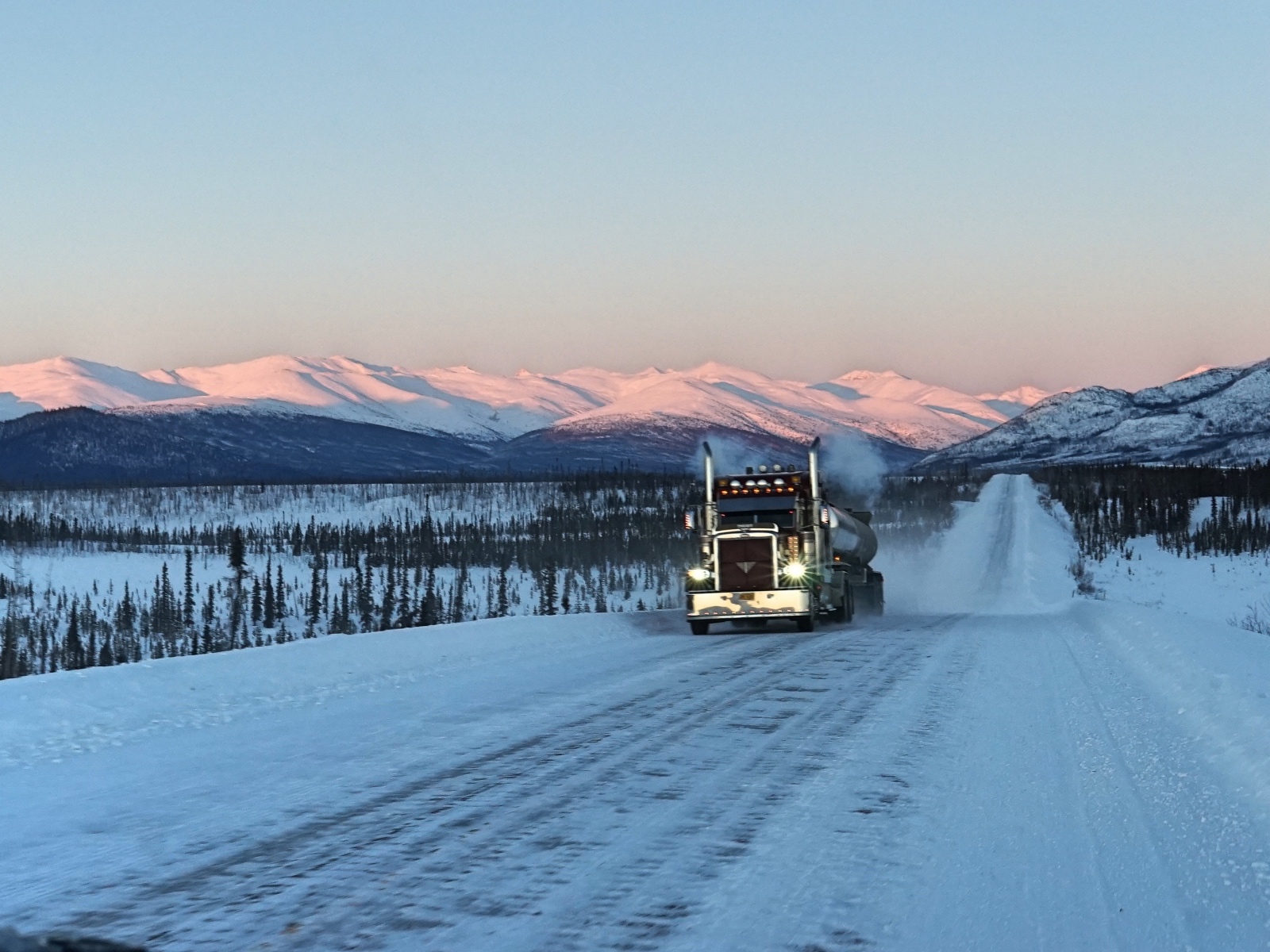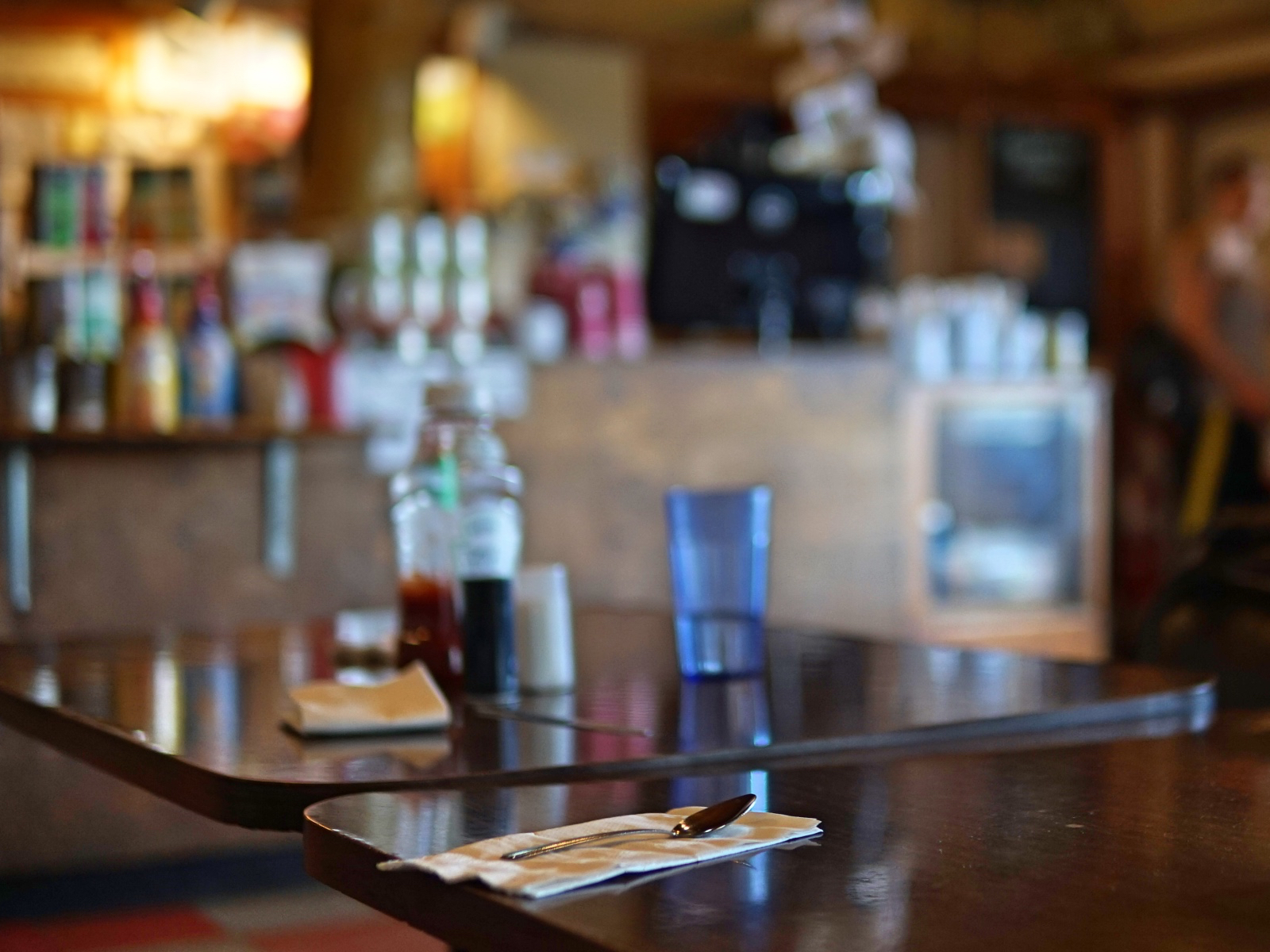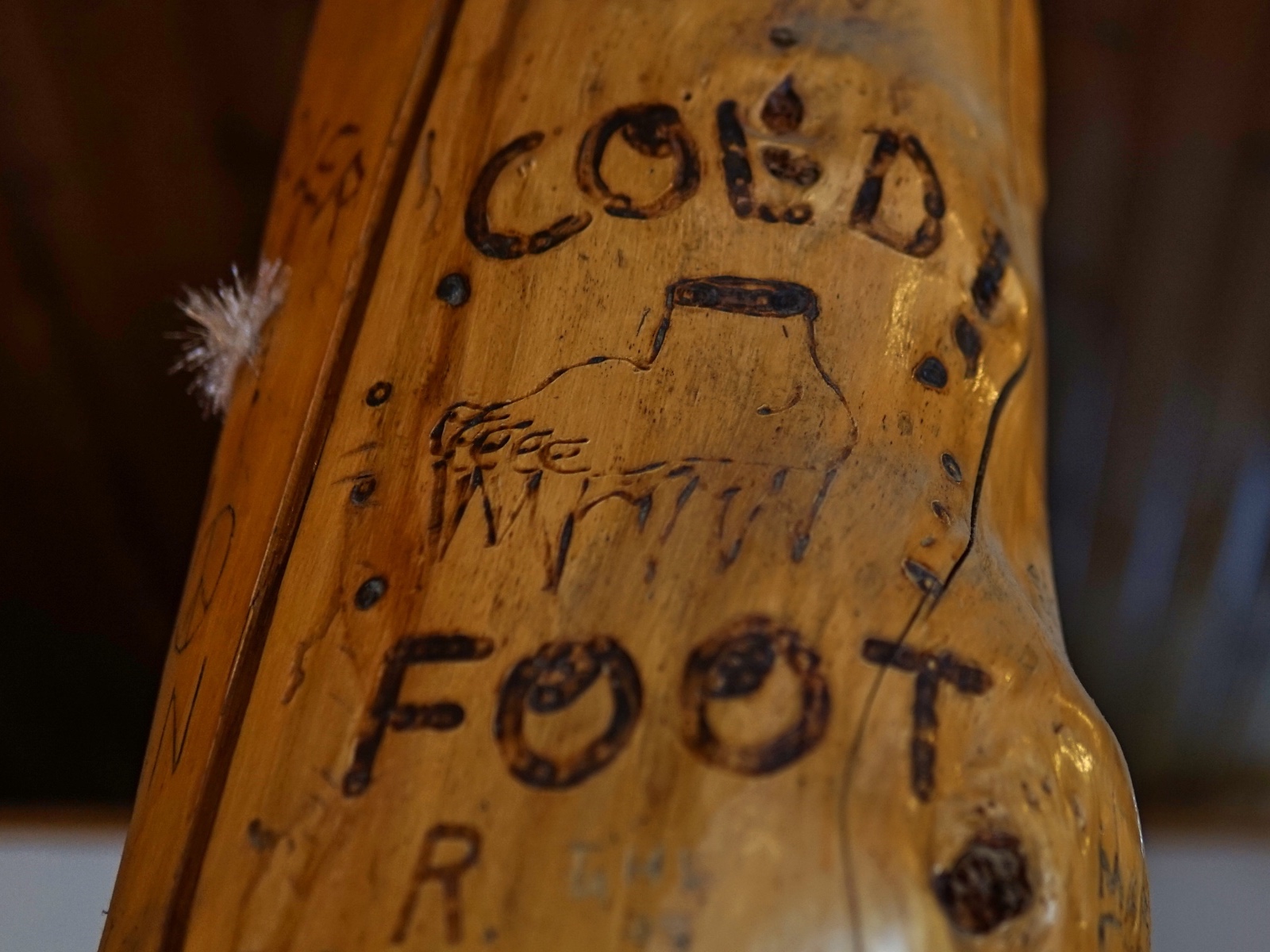A Winter in the Pit: Washing Dishes in the Alaskan Arctic

On a weekend holiday to Fairbanks, I stepped into Big Ray’s shop, where walls and racks were festooned with down jackets, wool hats, gloves, boots and face masks of every style and function imaginable. I have read that one measure of the dominance of winter is the number of words available to describe snow in the native languages of that region. I now knew that another indicator was the abundance and variety of long underwear available at local retailers. Each pair was categorized by the level of cold it was designed to withstand, one labeled “Very Cold” and the other “Extreme Cold.”
As I approached the man at the front counter, I explained to him that I was new to Alaska but I didn’t want to overdo it by getting the really heavy-duty stuff when regular heavy-duty would suffice.
“I’m from Chicago,” I added helpfully, to let him know I wasn’t a total wuss when it came to cold.
“I don’t think there’s anything you can do that’s gonna properly prepare you for what you’re about to experience this winter,” he said. He wasn’t smiling.
I opted for both pairs and some wool socks.
Coldfoot Camp is located on Mile 175 of the Dalton Highway. At 60 miles north of the Arctic Circle, it’s the world’s northernmost truck stop. It’s been featured on the show Ice Road Truckers, and its hiring website indicates (with wicked glee) that it is 260 miles north of the nearest stoplight, in Fairbanks.
The opening was for a dishwasher who could start that summer and stay on for the winter season. I’d previously dished at a four-diamond, all-vegan resort on the coast of Northern California. It would be difficult to find a more antithetical restaurant experience than a truck stop in the Alaskan Arctic, where an order of biscuits and sausage gravy with hash browns and two eggs any-way-you-like-‘em was listed on the menu as the “Trucker’s Favorite.” But dishing is dishing, anywhere you go. I applied. Two weeks later I was standing on the dirt runway of Coldfoot’s airstrip.
At each stop along my journey north the planes grew smaller until I eventually sat aboard a 9-passenger bush plane with a honking pair of headphones clamped over my ears. Once airborne, our pilot flicked the controls into autopilot and turned on the local sports station. It faded to static as we passed beyond the range of Fairbanks’s airwaves and into a sprawling landscape of boreal forest and tundra, pockmarked by lakes and slithering with rivers. The vista was daunting, but its most dramatic feature lay buried beneath a cloak of green. The presence of permafrost — a permanent layer of frozen ground beneath a thin slip of soil — was indicated by dwarf trees, blocked from digging deep root systems that anchor taller growth.
“Winter is a constant, though usually hidden companion during the short Arctic summer,” writes John Milton. “The quickness of summer intensifies an awareness that warmth here is only a brief respite from cold, that light will soon be followed by a deep and much longer-lasting darkness. This mood dominates the land and everything living in it.”
Or as MudD, our maintenance man would later put it to me, “Summer’s almost over before it begins.”
From the air, two feats of human industry can be traced zigzagging north towards the Arctic Ocean like scars on an otherwise unmarred landscape: the Trans-Alaska Pipeline, and its correlating artery, the Dalton Highway. The pipeline pumps oil from Prudhoe Bay 800 miles to the port of Valdez, while the highway supplies the truckers and pipeline crew necessary to keep it flowing.
Coldfoot Camp is the midway point for anyone headed north or south on the Dalton. It’s a big dirt lot with a little oasis of gas pumps — open pasture for semi trucks. On one side of this lot was the cafe where I would be spending much of my time. It was a modest building with a slightly less industrial feel than anything else around it and the only commercial enterprise for hours in either direction. Rising 20 or so feet from its roof was a conical red flag, the kind that inflates and turns its narrow end to indicate the velocity and direction of the wind. On breezeless days it looked like a sad, droopy hat.
Across the lot sat a pair of long, white buildings with a likeness to a couple of heavy-duty trailer homes. ATCO units installed in the 70’s for crew workers on the Trans-Alaska Pipeline, they’ve since been rechristened as the Coldfoot Inn. Glamorous, not so much, but a person doesn’t come to the Arctic to admire the wall art.
Another set of ATCO units behind the cafe housed my fellow coworkers and me. Over the course of my time living in the crew quarters, I grew quite fond of my room with its decades-out-of-fashion, wood-paneled walls and ominous red carpet stain. Though I doubt I’ll miss the ancient heating system, which seemed to have two modes: Off or Inferno. There were -40 degree nights, window wide open, that I woke in a slick of sweat.
Coldfoot’s owners employ the word “rustic” to describe the feel of the place, though some might find that to be a coy description. Personally, I think it fits. The cafe was scuffed and chipped from the floor to the dinner plates, exactly how an Arctic truck stop ought to be. An amateur mural featuring trucks and mountains stretched the length of a wall. Laminated posters provided information on note-worthy events in the construction of the Dalton and the Trans-Alaska Pipeline. Pinned above a bay in the building was a large Christmas wreath with a toy semi truck inside of it. It was all wonderfully earnest. I would have been thoroughly disappointed had I come this far north only to find a brightly lit, standardized retail space across the street from a McDonalds and an outlet mall. There was an authenticity in the homeliness that reminded me why I continue to seek these kinds of places out.
Life at a Coldfoot was like life on a ship. You worked together, lived together, ate together and sat on the same toilets. Some co-workers dated each other. Several tied the knot. You had your own room, but walls with the soundproofing capabilities of cardboard meant privacy was limited. In the dead of winter, when gray light crept into the sky for no more than four hours a day and temperatures dropped below -40 degrees, taking a walk to clear your head became an expedition, conditions that reduced certain among us to periods of locking ourselves in our rooms, getting drunk and madly scribbling in Sudoku puzzles.
The job attracts interesting people. We went by a collection of names that, read off a roster, made us sound like a band of pirates. There was Maniac, the sweetest, most demure person I’ve ever met; MudD, a body-building movie-holic; and Tugboat, who spent over 100 days out of the year sleeping in a bivy sack on the side of the Colorado River.
Then there was Cast Iron, a big-bellied man in his 60’s enraptured by the Arctic. “I got up here late in life,” he liked to say. “There’s just too much for me explore to think about going anywhere else.”
Cast Iron put most of us to shame with the enthusiasm he displayed tromping out into sub-zero temperatures or riding his bike along the Dalton. He invited me out to his campsite in the woods where we heated our dinner over an open fire. Flames crackling in the fierce cold, we sipped our hot soup under a sky smattered with stars.

First it was a gold mine. Then it was a ghost town.
Miners settled what was originally known as Slate Creek in the final years of the 19th century. They established a gambling hall, two roadhouses, two stores and seven saloons. The name Coldfoot is supposedly a jab at the ones who got cold feet and tail-ended it back south. The area must have proved to be less a fountain of wealth than the miners had hoped, so the mining operations relocated to Wiseman, about 12 miles up the nearby Koyukuk River, between 1911 to 1912. Some of the local topography owes its name to the original camp’s ladies of the night. Today, Emma Dome looms over the highway.
In 1968, an estimated 10 billion barrels of recoverable oil was discovered at Prudhoe Bay, inciting the construction of the Trans-Alaska Pipeline. Coldfoot had a second coming as one of 29 camps housing some of the 70,000 pipeline construction workers from ’75 to ’77. The pipeline years were followed by another period of disuse.
Then along came Dick Mackey: Iditarod champion, Alaskan legend and an ambassador of sorts for the Dalton highway.
Mackey realized that Mile 175 was an ideal spot for truckers who needed to hit the head on the trip between Fairbanks and Prudhoe. So in 1981 he parked an old school bus there and started serving them coffee. Coldfoot’s wood center pole is inscribed with dozens of names, truckers who put a hand in helping build the cafe up from its humble beginnings. It is a chronicle of the Dalton Highway and the people who’ve driven it since its inception, as well as the literal backbone of the building.
Our main customers were those truckers driving materials up to America’s largest oil field by way of America’s northernmost state-maintained road. The road was completed in 1974 in preparation for the construction of the Trans-Alaska Pipeline. Truckers still refer to it by its former name, the Haul road. By 1995, all 416 miles of the Dalton were open to the public. Anyone wishing to drive to its northern terminus at the gateway to Prudhoe Oil Bay, Deadhorse Alaska, (and grab a drink at the local Starbucks, I’m not kidding) can do so, but most of the road remains unpaved, and it is prone to chewing cars up and spitting them out.
Some say that the Dalton’s notoriety is overstated, but cars go off the road every year. Their metal carcasses haunt the roadside for months or even seasons on end before anyone gets around to hauling them out. Semi trucks command the Dalton, hurdling by, snow or dirt gusting up from their tires, engines bellowing miles off like gargantuan creatures prowling their territory. No surprise I found myself tensing up around a few curves while hitching a ride in one of these monsters back to Fairbanks one day.
As I gazed out his mud-splattered windshield, my ride Jim kept me entertained with stories of harrowing moments on the job. Heating a frozen jack with a blowtorch while changing a tire in -30-degree weather, flash blizzards that obscured visibility to the point that you couldn’t tell whether you were driving down the middle of the road or over the edge, and the rush of vertigo brought on by snow whipping sideways past your window.
In one particularly vivifying story, Jim had parked his truck on an icy slope after realizing he wasn’t going to be able to make it to the top. Just as he finished wrapping his tires in chains, the truck began to slide backward. Jim raced around to the driver’s side but couldn’t manage to jump in before it picked up speed. He watched in horror as the semi’s back end began jack-knifing towards the side of the road. Then the chains caught. The wheels rolled over on their brakes and ground to a halt, their back-most members dangling over a steep descent. Listening to him talk I couldn’t help sense the potential for a T.V. show. And then I remembered, there already was one.
So why live in a truck stop in the Arctic? The least romantic answer: It’s lucrative.
Many of us were travelers. With no rent, no grocery expenses and nowhere to spend our money (except the internet, thank you Amazon), saving up for future trips became incredibly doable. Zero commute and less commercial distractions allowed a person to focus on what’s important to them. The ability to come and go without the anchor of a lease agreement made the live-where-you-work factor ideal for roaming. All that being said, the most obvious reason for living in the Arctic was that you got to live in the Arctic.

The foothills of the Brooks Range rose up beyond the rooftops of camp, massive rock faces poised to capture an array of colors as resplendent as the Arctic is ongoing, from the deep pinks, reds and violets of dawn and dusk, to the burly slate and steel blue of frigid winter days. We name them, claim them, divide them by political boundaries, but all that seems like nonsense when you’re staring up at one. Nobody conquers a mountain. It gazes down upon our line drawing and nation building like someone watching a child carve moats and sandcastles on the beach. If you have any thoughts to the contrary, walking up one will help dispel the illusion.
A hike during the warmer months most likely means stream fording and bushwhacking, as this country is backcountry, and trail systems are almost exclusively the product of wildlife. There is no gift shop at the top of these Arctic mountains, no gondola ride from the summit. You earn only the steps you take.
In my case, I also earned an encounter with a very large brown bear. A bear can be happened upon in one of two states: either it’s hibernating or it’s hungry. I decided this one belonged to the second category, calculating how many seconds it would take to reach me if it charged (a bear can cover 40 feet in a second: so about two, I figured). The canister of bear spray that had cast an aura of safety around me up until then, bouncing on my hip like a trusty revolver, seemed about as useful as a can of DEET under the purview of an actual bear. After a few pulsing moments, the bear turned its nose down the mountain, a mutual disinterest in pursuing further relations with one another agreed. We went our separate ways but I was shaken for the rest of the day, glancing over my shoulder in case the hulking, furry animal changed its mind.
Beyond bears, the cold itself became a beast. As winter turned full tilt and temperatures fell below nose hair-freezing levels, the urge to escape the doldrums of the ATCO units during the slim hours of daylight grew strong enough to suit me up in nearly every article of cold weather gear I possessed and scoot me out the door.
This was, admittedly, on a warmer winter day, somewhere in the negative tens. The hike that followed took me through open tundra and over frozen lakes, at one point descending steeply through a strip of boreal forest in snow so deep and powdery that even with snowshoes I sank to my waist and on to the top of a deceptively squat-looking mountain called the Nub. Six hours round trip, during which I sweated through my down jacket and thanked my lucky stars I’d thought last minute to stuff another into the bottom of my pack, I stripped off one and pulled on the other. The wet rag (formerly my jacket) made a crinkling sound as it solidified into a hunk of ice.
It could be easy while among the creature comforts of a central-heated truck stop and crew quarters to feel immune to nature’s elements. During the short walk between the two buildings, the cold became a nuisance rather than a death threat. Hiking the backcountry, however, provided plenty of reminders that this was still the Arctic. It didn’t care where you came from or who you knew. It had no qualms turning you into a permanent fixture of the landscape.
Inside the main entrance of the crew quarters was a landline telephone. The sign posted next to it read: “Welcome to Coldfoot, one of the last places on Earth where your cell phone doesn’t work.” By the time I arrived, that sign was out of date. The first cell tower to be erected along Mile 175 had gone active a few months earlier. An outpost on the edge of human civilization feels a lot less rugged when the person next to you is thumbing around on Facebook.
Over the long winter haul, I woke in the dark, rubbed my eyes, pulled on my uniform and trudged to work. Some mornings, when I questioned what I was doing out there when I was feeling less like a frontiersman and more like a dishwasher, it was worth looking up. Within seconds, eerie rivers of green and pink light could flood the sky and just as quickly dissipate again. The Aurora appeared now and then as a kind of reassurance that the world was still a wild, beautiful place.
My bags were packed. It was mid-May and spring was just finally bursting up through the snowpack. People were outside in T-shirts tossing around a Frisbee. Incredible. An hour after clocking out of my final shift I was on a plane headed south. I was meeting a friend in Fairbanks for an Alaskan road trip, during which we’d both get miserably sick but have a hell of a good time anyways.
The plane pitched to turn us south, offering one last glimpse of the small cluster of buildings by the highway that was Coldfoot Camp: gold mine, truck stop, outpost, Alaska.

 Maximilian Armstrong has a penchant for adventure and stories. He’s backpacked Canada, hitchhiked America, motorbiked Vietnam and wintered in the Alaskan Arctic. His current expedition is thru-hiking the Appalachian Trail.
Maximilian Armstrong has a penchant for adventure and stories. He’s backpacked Canada, hitchhiked America, motorbiked Vietnam and wintered in the Alaskan Arctic. His current expedition is thru-hiking the Appalachian Trail.
